| Article ID | Journal | Published Year | Pages | File Type |
|---|---|---|---|---|
| 5985508 | Journal of Clinical Lipidology | 2015 | 9 Pages |
â¢This was a randomized, double-blind, crossover, controlled feeding trial.â¢Hypercholesterolemic adults were fed 4 tablespoons/d of corn oil and extra-virgin olive oil, each for 21 days, as part of a diet low in saturated fat.â¢Corn oil produced significantly (P < .001) larger reductions from baseline in LDL-C (10.9% vs 3.5%), total-C (8.2% vs 1.8%), and non-HDL-C (9.3% vs 1.6%) than extra-virgin olive oil.
BackgroundRestricted intakes of saturated and trans-fatty acids is emphasized in heart-healthy diets, and replacement with poly- and monounsaturated fatty acids is encouraged.ObjectiveTo compare the effects of polyunsaturated fatty acid-rich corn oil (CO) and monounsaturated fatty acid-rich extra-virgin olive oil (EVOO) on plasma lipids in men and women (N = 54) with fasting low-density lipoprotein cholesterol (LDL-C) â¥130 mg/dL and <200 mg/dL and triglycerides (TG) â¤350 mg/dL.MethodsIn a double-blind, randomized, crossover design (21-day treatments, 21-day washout between), 4 tablespoons/day CO or EVOO were provided in 3 servings study product/day (muffin, roll, yogurt) as part of a weight-maintenance diet (â¼35% fat, <10% saturated fat, <300 mg cholesterol). Subjects ate breakfast at the clinic every weekday throughout the study. Lunches, dinners, and snacks (and breakfasts on weekends) were provided for consumption away from the clinic.ResultsBaseline mean (standard error) lipids in mg/dL were: LDL-C 153.3 (3.5), total cholesterol (total-C) 225.7 (3.9), non-high-density lipoprotein (non-HDL)-C 178.3 (3.7), HDL-C 47.4 (1.7), total-C/HDL-C 5.0 (0.2), and TG 124.8 (7.2). CO resulted in significantly larger least-squares mean % changes (all P < .001 vs EVOO) from baseline in LDL-C â10.9 vs â3.5, total-C â8.2 vs â1.8, non-HDL-C â9.3 vs â1.6, and total-C/HDL-C â4.4 vs 0.5. TG rose a smaller amount with CO, 3.5 vs 13.0% with EVOO (P = .007). HDL-C responses were not significantly different between conditions (â3.4 vs â1.7%).ConclusionConsumption of CO in a weight-maintenance, low saturated fat and cholesterol diet resulted in more favorable changes in LDL-C and other atherogenic lipids vs EVOO.
